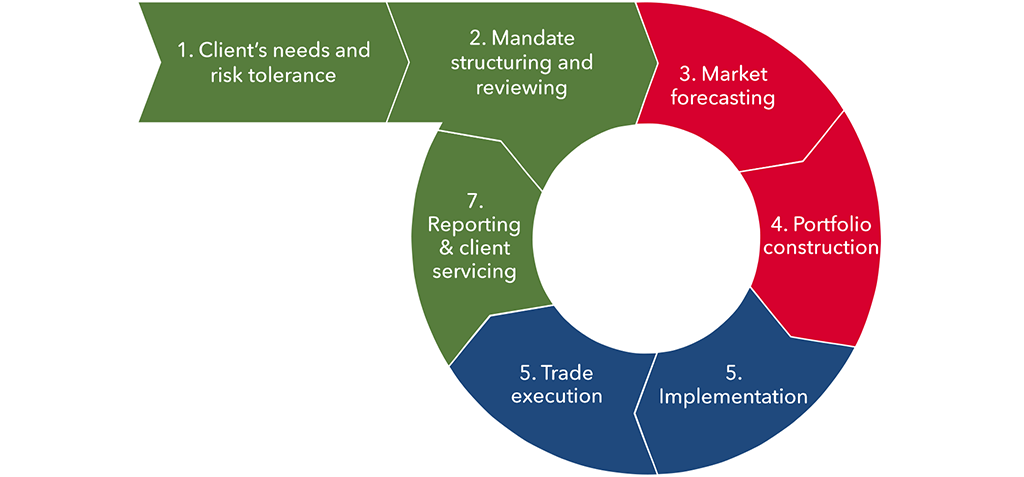Private Banking is about trust and delivering on promises made. Successful private banking solutions focus on managing the trust accounts of their clients. Forecasting markets and constructing risk optimized portfolios is no longer the only area of innovation. Private banks need to focus on all components of the wealth management value chain to (re-)gain trust. Innovation is about teamwork putting the client to the forefront and transforming ideas into innovative solutions in which the client trusts and this is willing to pay an above market fee.
Understanding the challenges currently faced by the private banking industry, especially with respect to discretionary mandate offerings, requires getting a handle on their unique characteristics. In a discretionary mandate, the client entrusts his/her wealth to a private bank who promises to manage it towards agreed upon targets, usually generate a positive return. The key characteristic of the offering is the word entrusts. Private banking is about trust. A recent study has shown that the trust factor can be decomposed along the three dimensions i) reliability, ii) intimacy, and iii) credibility. These trust levels can be modeled as a portfolio of trust accounts, similar to Stephen Covey’s emotional bank account concept. The goal of innovating in private banking is focusing on increasing the value of all of three trust accounts. The balanced of the trust accounts is directly linked to the client’s willingness to pay and pay above market fees.
IT IS ALL ABOUT MANAGING RISK, ISN’T IT?
At least since the publication of Markowitz’s seminal paper on portfolio selection in 1952, the focus in discretionary mandates is on generating performance in a risk-return framework. Generating consistent performance matching the promises made allows increasing the client’s reliability trust account. But the recent financial crises have reminded us the hard way, that generating above risk free rate returns, requires taking risks. The core of any discretionary mandate must therefore be the decision to invest in certain risks and not others. The selection of risks taken should be such that the portfolio manager expects a majority of the risks not to materialize. These risk selection decisions are called investment decisions. Correct investment decisions transform the portfolio manager’s skills into deposits into one or more of the client’s trust accounts. On the other hand, incorrect investment decisions usually result in a (large) withdrawal from one or more of the trust accounts. An empty trust accounts usually leads to the cancelation of the discretionary mandate. But there is more to trust than just investment decisions.
A VISUAL FRAMEWORK FOR GUIDING INNOVATION
Braden Kelley describes in his recent book on innovation Stoking your Innovation Bonfire how the customer journey can be used to structure the innovation process. This concept can be applied, in a broader context, to the wealth management value chain illustrated in Exhibit 1. Consider the different stages involved in managing a discretionary mandate and delivering the results to the client. They can be classified into three categories, that is, client intimacy (green), investment skills (red), and execution (blue) as shown in Exhibit 1.

CLIENT INTIMACY
Client intimacy is about identifying and understanding the client’s needs, risk capacity and tolerance (risk profile). A key focus is on building intimacy trust. In a second step the discretionary mandate is structured in agreement with the client’s expectations, that is, the promise made by the private bank is formulated. Credibility trust plays a key role. Finally, the private bank needs to report back to the client how his/her discretionary mandate has been constructed and how it delivers on its promises. This allows increasing the reliability trust account.
INVESTMENT SKILLS
Investment skills are the basis for forecast markets, that is, selecting where risk should be taken. Investment skills are also needed to construct a risk managed portfolio that mirrors the forecasts and meets the client’s needs and risk profile as agreed upon.
EXECUTION
Execution is about implementing the constructed portfolio using cash and/or derivative instruments by generating trades. Trades are executed in accordance with best execution principles
At each of the seven stages of the wealth management value chain, it is possible to provide services that are perceived as added value by the client, that is, increase one or more of his/her trust bank accounts. As it is always possible that one or more of the made promises cannot be fulfilled, it is key to design any discretionary mandate in such a way that it promises multiple sources of added values, not only focusing on the most difficult one, market forecasting.
For example, to increase the intimacy trust account, at stage three of the wealth management value chain, the discretionary mandate could include a process that pro-actively reviews the client’s expectations and subsequently proposes changes to the discretionary mandate structure.
Another area of innovation, focusing on technology, could be to offer a reporting platform which allows the client to directly customize his reporting using a flexible, but easy to use, mobile app. The credibility trust account, though providing transparency, would be topped up.
AND HOW ARE WE GOING TO DO IT?
Before starting any innovation project, it is mandatory to have an innovation vision and a strategy. Only so is it possible to focus and prioritize.
A key premise for success is free flow of information. The not invented here syndrome must be avoided at all cost. Existing and potential clients should be involved from the beginning. Keep in mind that the client is always right. He/she only sometimes has a hard time to express his/her needs in a language that does allow designing a sound discretionary mandate.
A cross functional team including passionate experts from different areas within the private bank, should be involved to assure high quality ideas in enough quantity along the whole wealth management value chain. Expertise and experience must dominate over seniority. The most common techniques for generating ideas that can be transformed into innovation through matching them with client needs are
- moderated brainstorming sessions,
- suggestion boxes, and
- targeted challenges.
Ideas should be prioritized to match the imperatives of the private bank’s strategy and geared towards increasing the balance of one or more of the trust accounts. Bear in mind that any deposit in your trust accounts should be such that it will allow you to sell more and/or at a higher price.
Any input provided should be valued. Providing feedback on any idea and allowing a not now negative response is important. Allowing for failure and putting all efforts in place to make failures happen as soon as possible. It is only through failing that an organization can learn.
Innovation is the transformation of ideas, into a solution valued above every existing alternative by the client. Private banks should thrive for the best and be client-focused.
Finally, innovation is about change. This requires the private bank being ready for change before engaging on any innovation journey. Otherwise failure is pre-programmed.
LESSONS LEARNED
- Discretionary mandates are about trust. Trust factors can be classified in three categories, that is, reliability, intimacy, and credibility.
- Although forecasting markets and taking risk is a key component of a discretionary mandate, it is not the only area of innovation. Clients demand more.
- The wealth management value chain concept brings structure into the innovation process.
- Innovation management is teamwork and requires free flow of information. It results in changing the organization in being more customer-focused.
